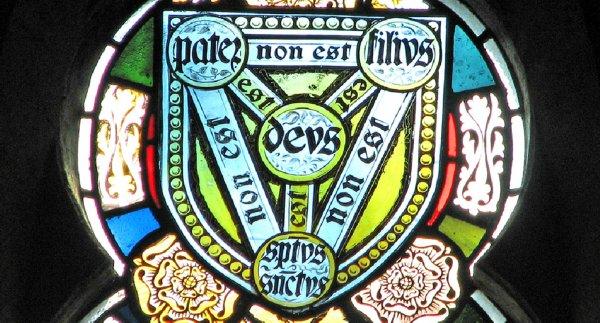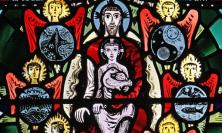Paul D. Murray concludes his series on Thinking Faith by exploring key elements in a fundamental theology of dialogue and pointing to their implications for our understanding of Catholic truth. He indicates the challenges presented by dialogue to our ways of living and being as Church.
The Trinity and Revelation – a Contribution to a Fundamental Theology of Catholic Learning through Dialogue
We have already touched on some of the more directly pragmatic grounds for the adoption of a receptive move within Catholicism in the context of Christian ecumenism, in as much as this is what is required if we are to make any further progress. Similarly, we have turned the corner of the page a little on some of the more directly theological and specifically Christological grounds for such a move. I now want to take this further by reflecting awhile on the theology of the Trinity and what this implies for our understanding of God and the attitude we might bring to our engagement with the other, whoever that other might be, whether another within Catholicism, a fellow Christian other, or a non-Christian other.
In essence I want to say that the theology of the Trinity, taken both as a whole and in its various parts, is suggestive of there always being more to the being and reality of God than we and, indeed, our Catholic Christian tradition, have thus far understood and experienced. This is what it means to speak of God as mystery. Too often in sermons on Trinity Sunday this is used as a theological excuse for being incapable of saying anything sensible at all. Theologically speaking, mystery is not an absence of all knowledge but an intensity of reality such that it eludes full or exhaustive understanding. It is not that what Catholic Christianity understands about God as Trinity is not true; nor that this might be fundamentally contradicted by this potential ‘more’ to which I refer. It is simply to say explicitly the rather obvious point that our understanding – individually and collectively – is partial. Let’s explore awhile how the Trinity takes us into such an understanding.
First I want to do something that appears to contradict what I am saying about the Trinity as mystery and that is to give a clear sense of the way in which our experience – our experience of God certainly, but also our experience of reality more generally – is Trinitarian in form. To do this, let us turn for a moment from the explicitly theological and let me take you on an imaginative journey to a place of great natural beauty in which you feel connected. For me one such place, which I’m sure many others of you will also know, is the shore of Derwentwater in the Lake District, somewhere near Ruskin’s View, with Friar’s Crag to the rear and Catbells in front, reflected in the water and the fells stretching out beyond.
The experience of drinking in this scene, of being there and connecting with it – an experience that is deeply unifying in some respects – is also, I suggest, an experience that has a definite Trinitarian, three-fold, form. First and most obviously, there is the experience of seeing what is there – the fells, the sky, the particular quality of light and meteorological conditions, the surface of the water, dancing, glistening and reflecting the fells; there is, we might say, what is shown to us. But second, we become aware that what is shown is not static, there is movement, dynamism; the movement of the clouds, the movement of the trees and of the water, the movement of the breeze upon our face, and the movement in our senses, mind and heart; indeed, we become aware that this multi-levelled movement is what brings forth what is shown – the movement of the clouds, of the water, of the trees is what brings to pass the unique, particular showings that we experience and, similarly, it is the movement in our senses, minds and hearts that connects us with it and makes of it the experience that it is. So, we have showing forth and recognition and the energy, the movement, that brings this to be, but there is also a third dimension to the experience. This is the dimension at once of limitedness and excess; the dimension of both appreciating the intensity of the particular scene we behold and recognising it precisely to be particular and partial. Our eyes are drawn to Catbells and the prospect of a fine day’s walking and at once we are conscious of the other fells beyond, Causey Pike and the Coledale Horseshoe in one direction, the Borrowdale volcanics in another, we vaguely picture some of the other scenes, other showings that lie beyond and in doing so are aware of the myriad other scenes, other showings, that we cannot even imagine. Similarly, we look at water and delight in it but know it to be the showing only of the surface, only of what is open to view, the intensity of which is tied up with the depths that lie beneath. There is always more.
To experience reality in this three-fold way is, I suggest, to experience reality in its deep Trinitarian form, and I mean that in a strong sense. I am not just saying that this experience, in as much as it has a three-fold quality, is suggestive of the Trinity which is also going on about three-fold realities. I am not just looking for patterns of three and making theological capital out of them. Rather, I am saying that in as much as all of creation – to go back to where we started – comes into being, is held in being and orientated towards the Trinitarian being of God, then all of reality can be properly expected to reflect something of that Trinitarian form when viewed aright. Accordingly, what I am suggesting is that in experiencing reality in the way that I have outlined, we experience something of God as Trinity. This can also suggest to us how we might pray to God as Trinity; how we might wait upon God as Trinity: it means waiting upon God as shown forth, as expressed Word in Jesus, in Scripture, in sacrament, in the saints, in sensed encounter with something of the reality of God; it means waiting upon God as creative, energising Spirit under whose searching, inspiring, transforming initiative all such showings unfold; it means waiting upon God as inexhaustible source of all that exists who simply cannot be captured in word, image or experience.
Nor is this a temporary state of affairs; the consequence of the conditions of temporality and finitude under which we currently live. It has to do with the very reality of God; the sheer, inexhaustible intensity of God who is the act of being without limitation and without qualification. Some of the ways in which we speak of the beatific vision may lead us to assume otherwise; as might the contrast that St Paul draws between the present quality of our seeing as in a glass darkly and our future seeing of God face-to-face. But seeing face-to-face is about proximity and assurance of reality. It is not about seeing and understanding everything entirely transparently. Look at us here this evening. We are seeing each other face-to-face, but the mystery of our respective being is not thereby foreclosed. On the contrary, it puts us in the place wherein we can begin to take the mystery of each other’s being seriously. This is a great image for what the married vocation is about: it is about living before the face of another, living into the mystery of their being, and as we become more familiar so also allowing this mystery to intensify rather than lessen. Analogously, St Gregory of Nyssa in his great reflection on the Christian mystical life, The Life of Moses, explores the way in which the promise of heavenly beatitude is not about exhausted stasis but about our growing forever more deeply into the infinite depths of God; of our being conformed more fully to the risen and ascended Christ in whom alone the fullness of God is expressed; of our being led by the Spirit who searches the infinite depths of God and who, it is promised, will lead us into all truth. Let’s read Ephesians 3: 14-21 in this light:
For this reason I bow my knees before the Father, from whom every family in heaven and on earth takes its name. I pray that, according to the riches of his glory, he may grant that you may be strengthened in your inner being with power through his Spirit, and that Christ may dwell in your hearts through faith, as you are being rooted and grounded in love. I pray that you may have the power to comprehend, with all the saints, what is the breadth and length and height and depth, and to know the love of Christ that surpasses knowledge, so that you may be filled with all the fullness of God. Now to him who by the power at work within us is able to accomplish abundantly far more than all we can ask or imagine, to him be glory in the church and in Christ Jesus to all generations, forever and ever. Amen.
To taste something of this is not to have our thirst, our desire, sated but to have it simultaneously both met and intensified, purified and deepened.
Here we have the deep structure of a Catholic Christian theology and practice of dialogue. It is not simply that we need to find ways of rubbing along with our fellow Catholics, our fellow Christians, our fellow humans for the sake of good manners and good order. We are called deeply to take the way of dialogue seriously because the being of God is itself dialogue; a being through the Word in the Spirit and it is into this dialogical being of God that we are being drawn. This is the truth and the way towards it disclosed in Christ. This is the truth in which we share. But notice the language there: we share in this truth but we do not possess it. Rather, it possesses, or is in process of taking possession, of us and, as such, is a truth into which we, both as individuals and collectively, have still to grow further. It is not exhausted by what we already have and know and hence our antennae must be constantly alert, whilst also appropriately fine-tuned and discriminating, to what fresh things there are to learn of God’s ways in Christ and the Spirit and from even the most surprising of places.
The history of Christianity and of Christian mission has always known this. Take the Gospel narratives themselves. Here we are presented not with straightforward historical reminiscences of the life of Jesus but with accounts that have been reworked in the light of the diverse experiences of the later communities. This is not a case of distortion. Rather the point for the early communities and for Christianity ever since was that vitally important though the historical life of Jesus was, it is the risen and ascended Lord and not simply the historical Jesus who is the full expression of God. As such, this is something that is present to us and, indeed, that lies ever ahead of us, breaking in afresh, and not simply something confined to a period some 2,000 years ago. Again, just think of the diverse expressions of Christianity that have emerged over the course of Christian history as Christianity has become incarnated in and shaped by quite different linguistic, cultural, intellectual and historical contexts. To say that there is more for Catholicism to learn is not to compromise Catholic truth. Rather, it is to take the dynamics of living into that truth absolutely seriously.
Dialogue and the Church
These fundamental perspectives bring us, I think, to the threshold of being able to explore the various particular areas of Catholic dialogue in right view. Had time permitted and had I not succumbed to the tendency to prolixity that my friend so correctly identified, I would have drawn this talk to closure by spending some time reflecting on the thorny issue of dialogue in the Church. In reality, I think that that is probably a separate talk. In this regard, let me simply say that the sign-value, the sacramentality, of the Church itself desperately requires that we grow from a community that frequently seems incapable of knowing even how to begin a serious conversation, to becoming a community that for the sake both of its own flourishing and the good of the world can develop and become practised in the ethos, habits, virtues, processes and structures that would enable it to give sustained witness to the art of discerning the truth in common. It behoves each of us personally to seek to acquire these habits and virtues, as it does also for us imaginatively to take and sustain whatever opportunities are open to us in our respective situations to nurture spaces for collective Catholic conversation.
Paul D Murray is Director of the Centre for Catholic Studies and Senior Lecturer in Systematic Theology in the Department of Theology & Religion at the University of Durham. He is the Editor of the forthcoming volume, Receptive Ecumenism and the Call to Catholic Learning: Exploring a Way for Contemporary Ecumenism (Oxford University Press).
This article was adapted from the keynote lecture given by Dr Paul D. Murray the 2008 Living Theology summer school at Ushaw College, Durham.
![]() Read Part One of this series
Read Part One of this series
![]() Read Part Two of this series
Read Part Two of this series
![]() Living Theology
Living Theology![]() Centre for Catholic Studies
Centre for Catholic Studies![]() 'Receptive Ecumenism and the Call to Catholic Learning' edited by Paul Murray
'Receptive Ecumenism and the Call to Catholic Learning' edited by Paul Murray






